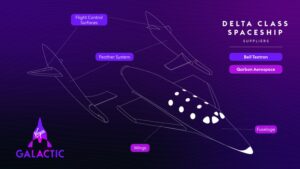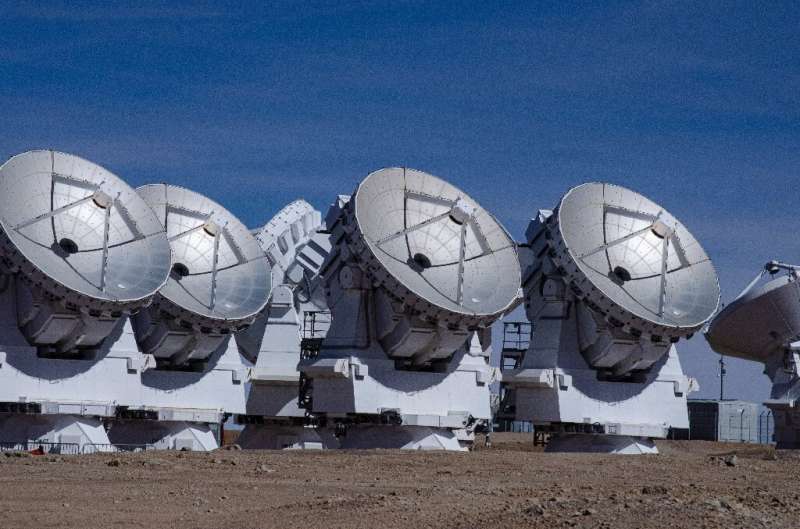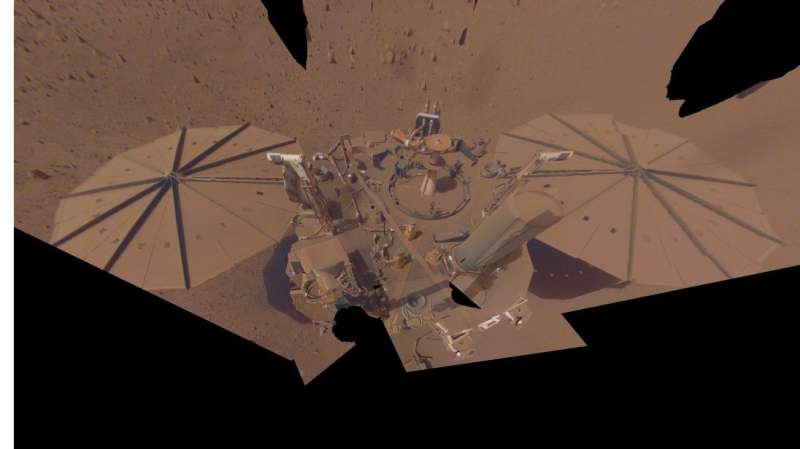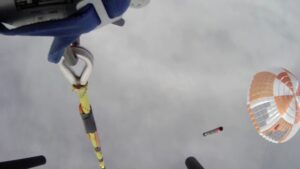Do you speak extra-terrestrial?
Thursday, 03 November 2022 05:03 What does humanity do when we discover we are not alone in the cosmos? A new international research hub at the University of St Andrews will coordinate global expertise to prepare humanity for such an event and how we should respond.
While we might never learn about the existence of life beyond Earth, or even about another intelligent civilisation, there's a chance it could be detected soo
What does humanity do when we discover we are not alone in the cosmos? A new international research hub at the University of St Andrews will coordinate global expertise to prepare humanity for such an event and how we should respond.
While we might never learn about the existence of life beyond Earth, or even about another intelligent civilisation, there's a chance it could be detected soo NASA probe back on track to reach moon after monthlong mishap in space
Thursday, 03 November 2022 05:03 NASA's CAPSTONE CubeSat space probe is back on track to reach the moon later this month after a glitch during engine maneuvers in September caused the craft to spin out of control.
A separate engine burn last week proved successful and set the craft's trajectory to arrive in the moon's orbit on Nov. 13, less than two weeks from now, the agency announced Monday amid a flurry of test miss
NASA's CAPSTONE CubeSat space probe is back on track to reach the moon later this month after a glitch during engine maneuvers in September caused the craft to spin out of control.
A separate engine burn last week proved successful and set the craft's trajectory to arrive in the moon's orbit on Nov. 13, less than two weeks from now, the agency announced Monday amid a flurry of test miss NASA makes progress with new Lunar Terrain Vehicle services
Thursday, 03 November 2022 05:03 As astronauts explore the South Pole region of the Moon during Artemis missions, they will be able to go farther and conduct more science than ever before thanks to a new Lunar Terrain Vehicle (LTV). Instead of owning the vehicle, NASA plans to contract it as a service from industry.
The draft request for proposals for the LTV Services (LTVS) contract is now ready for industry to review, a
As astronauts explore the South Pole region of the Moon during Artemis missions, they will be able to go farther and conduct more science than ever before thanks to a new Lunar Terrain Vehicle (LTV). Instead of owning the vehicle, NASA plans to contract it as a service from industry.
The draft request for proposals for the LTV Services (LTVS) contract is now ready for industry to review, a NASA sounding rockets launch multiple science payloads
Thursday, 03 November 2022 05:03 Newly proven technology developed at NASA's Wallops Flight Facility near Chincoteague, Virginia, turns a single sounding rocket into a hive deploying a swarm of up to 16 instruments. The technology offers unprecedented accuracy for monitoring Earth's atmosphere and solar weather over a wide area.
The Swarm Communications technology, as dubbed by its NASA Wallops creators, spreads sub-paylo
Newly proven technology developed at NASA's Wallops Flight Facility near Chincoteague, Virginia, turns a single sounding rocket into a hive deploying a swarm of up to 16 instruments. The technology offers unprecedented accuracy for monitoring Earth's atmosphere and solar weather over a wide area.
The Swarm Communications technology, as dubbed by its NASA Wallops creators, spreads sub-paylo Arianegroup to develop Phoebus for ESA to demonstrate future Ariane 6 Carbon Upper Stage
Thursday, 03 November 2022 05:03 ArianeGroup has received a 50-million-euro agreement from the European Space Agency (ESA) to continue the development of PHOEBUS, a super-light carbon composite upper stage demonstrator. This work will enable development of the next Ariane6 upper stage, by raising the maturity level of cryogenic composite technologies.
The objective is to reduce the weight of the upper stage by using carbo
ArianeGroup has received a 50-million-euro agreement from the European Space Agency (ESA) to continue the development of PHOEBUS, a super-light carbon composite upper stage demonstrator. This work will enable development of the next Ariane6 upper stage, by raising the maturity level of cryogenic composite technologies.
The objective is to reduce the weight of the upper stage by using carbo Resupply mission for NASA carries scientific experiments to ISS
Thursday, 03 November 2022 05:03 The 18th Northrop Grumman commercial resupply services mission for NASA to the International Space Station carries scientific investigations of topics such as plant mutations and mudflow structure along with a demonstration of camera technology and small satellites from Japan, Uganda, and Zimbabwe. The Cygnus spacecraft carrying these investigations to the orbiting laboratory is scheduled for li
The 18th Northrop Grumman commercial resupply services mission for NASA to the International Space Station carries scientific investigations of topics such as plant mutations and mudflow structure along with a demonstration of camera technology and small satellites from Japan, Uganda, and Zimbabwe. The Cygnus spacecraft carrying these investigations to the orbiting laboratory is scheduled for li Can't Touch This: Sol 3640
Thursday, 03 November 2022 05:03 We arrived at the spectacular workspace pictured above, but what made it spectacular - rocks - is what also made it tricky. Our left front wheel was propped up just enough on one of the lovely and interesting rocks to make it unsafe to unstow the arm. Thus, as Deirdra, one of my planning partners said - it felt like Mars was taunting us with some early 1990s MC Hammer.
Fortunately, the rov
We arrived at the spectacular workspace pictured above, but what made it spectacular - rocks - is what also made it tricky. Our left front wheel was propped up just enough on one of the lovely and interesting rocks to make it unsafe to unstow the arm. Thus, as Deirdra, one of my planning partners said - it felt like Mars was taunting us with some early 1990s MC Hammer.
Fortunately, the rov Planets can be anti-aging formula for stars
Thursday, 03 November 2022 05:03 Planets can force their host stars to act younger than their age, according to a new study of multiple systems using NASA's Chandra X-ray Observatory. This may be the best evidence to date that some planets apparently slow down the aging process for their host stars.
While the anti-aging property of "hot Jupiters" (that is, gas giant exoplanets that orbit a star at Mercury's distance or cl
Planets can force their host stars to act younger than their age, according to a new study of multiple systems using NASA's Chandra X-ray Observatory. This may be the best evidence to date that some planets apparently slow down the aging process for their host stars.
While the anti-aging property of "hot Jupiters" (that is, gas giant exoplanets that orbit a star at Mercury's distance or cl Virgin Galactic picks suppliers for future spaceplanes
Wednesday, 02 November 2022 19:29
Virgin Galactic will work with two aerospace manufacturers to provide the major components of its next-generation suborbital spaceplane.
The post Virgin Galactic picks suppliers for future spaceplanes appeared first on SpaceNews.
ALMA observatory in Chile targeted by cyberattack
Wednesday, 02 November 2022 18:11
The ALMA space telescope in the Chilean Andes suffered a cyberattack over the weekend that has downed its website and suspended its work, the observatory announced Wednesday.
ALMA, the world's most powerful telescope for observing molecular gas and dust, studies the building blocks of stars, planetary systems, galaxies and life itself, according to the European Southern Observatory (ESO), its co-operator.
The attack Saturday on ALMA's computer systems did not compromise its powerful antennas or any scientific data, it said on Twitter.
The cyberattack forced the suspension of astronomical observations, left the observatory with limited email services, and its website still offline four days later.
"The threat has been contained and our specialists are working hard to restore affected systems," said the ALMA tweet.
"Given the nature of the episode, it is not yet possible to estimate a date for a return to regular activities," it added.
Saltzman takes command as new chief of the U.S. Space Force
Wednesday, 02 November 2022 17:19
Gen. B. Chance Saltzman assumed command of the U.S. Space Force, and departing chief Gen. John “Jay” Raymond retired Nov. 2.
China’s mystery spaceplane releases object into orbit
Wednesday, 02 November 2022 12:27
China’s secretive reusable spaceplane has released an object into orbit, according to tracking data from the U.S. Space Force.
The post China’s mystery spaceplane releases object into orbit appeared first on SpaceNews.
NASA prepares to say 'farewell' to InSight spacecraft
Wednesday, 02 November 2022 12:27
The day is approaching when NASA's Mars InSight lander will fall silent, ending its history-making mission to reveal secrets of the Red Planet's interior. The spacecraft's power generation continues to decline as windblown dust on its solar panels thickens, so the team has taken steps to continue as long as possible with what power remains. The end is expected to come in the next few weeks.
But even as the tightknit 25-to-30-member operations team—a small group compared to other Mars missions—continues to squeeze the most they can out of InSight (short for Interior Exploration using Seismic Investigations, Geodesy and Heat Transport), they've also begun taking steps to wind down the mission.
Here's a glimpse of what that looks like.
Preserving data
The most important of the final steps with the InSight mission is storing its trove of data and making it accessible to researchers around the world.
Amazon, Microsoft, SpiderOak join Defense Innovation Unit’s hybrid space network project
Wednesday, 02 November 2022 12:17
The Defense Innovation Unit on Nov. 2 announced new agreements with Amazon Web Services, Kuiper Government Solutions, Microsoft Azure Space and SpiderOak Mission Systems.
The post Amazon, Microsoft, SpiderOak join Defense Innovation Unit’s hybrid space network project appeared first on SpaceNews.
Rocket Lab to attempt booster recovery on upcoming Electron launch
Wednesday, 02 November 2022 10:45
Rocket Lab says it will make a second mid-air recovery attempt of an Electron booster during the launch later this week of a Swedish scientific satellite.
The post Rocket Lab to attempt booster recovery on upcoming Electron launch appeared first on SpaceNews.

